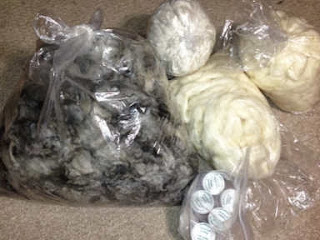I was pretty lucky as well because people look after each other here. I was loaned an umbrella, brought a cup of very interesting herbal tea which tasted very much of chocolate and was fed steaming hot potato soup for lunch. I worked with a young lady who despite being only in grade 7, was interesting, personable and quickly picked up what we needed to do for the demos. She jumped right in and helped out in a most welcome and useful fashion. It made for an enjoyable afternoon.
 We did a lot of baking, almost all of it pumpkin related. Not only did I bring pumpkin foods to bake, but a friend did as well. There were two different pumpkin pie recipes. Mine was from Miss Beechers Domestic Receipt Book from 1850, which was my cook book choice of the day. I'm not sure of the providence of the other pie recipe as someone else brought it for me to cook, along with a bread pudding stuffed in a pumpkin. I made a pumpkin corn bread (Miss Beecher 1850) which disappeared pretty quickly as samples. I also made a pumpkin yeast bread, based on the corn bread recipe which wasn't period at all, but wanted a contrast to the corn bread. I tried my hand at a raised paste pie, using Hannah Glasse's The Art of Cookery Plain and Simple, 1740, Cheshire Pie recipe. It's a pork and apple pie which is amazingly delicious.
We did a lot of baking, almost all of it pumpkin related. Not only did I bring pumpkin foods to bake, but a friend did as well. There were two different pumpkin pie recipes. Mine was from Miss Beechers Domestic Receipt Book from 1850, which was my cook book choice of the day. I'm not sure of the providence of the other pie recipe as someone else brought it for me to cook, along with a bread pudding stuffed in a pumpkin. I made a pumpkin corn bread (Miss Beecher 1850) which disappeared pretty quickly as samples. I also made a pumpkin yeast bread, based on the corn bread recipe which wasn't period at all, but wanted a contrast to the corn bread. I tried my hand at a raised paste pie, using Hannah Glasse's The Art of Cookery Plain and Simple, 1740, Cheshire Pie recipe. It's a pork and apple pie which is amazingly delicious. The recipes were pretty delicious. The pumpkin corn bread was fairly plain, having no sweetener in it and it probably could have used a tad more salt. If one were to add a couple of tablespoons of sugar or honey to it, the recipe would have been more appealing, although it was well liked.
Miss. Beecher's Pumpkin Bread ( 1850)
Stew and strain some pumpkin, stiffen it with Indian meal, add salt and yeast and it makes a most excellent kind of bread.
1.5 tsp yeast
1/2 tsp salt
1.5 - 2 cups pumpkin
Corn meal
2 tsp sugar
1 cup warm water
Mix sugar into warm water and stir until dissolved. Proof yeast in water mixture for about 10 minutes or until it starts to bubble up nicely.
Stir yeast into pumpkin, adding salt. Mix well. Add corn meal until batter is stiffer than a cake batter but not as firm as a bread dough. I think I used about 3 cups of corn meal. The actual amounts will depend on how moist your pumpkin is. Pour batter into greased pan. Let rise for about 40 minutes. Bake in a pre-heated oven, about 375° F, for about 35 minutes or until centre comes clean when tested with a toothpick and bounces back. (190° on a baking thermometer)
I'm guessing at the oven temp and time because the bake oven was actually 450° but cooling fairly quickly due to a breeze which had popped up unexpectedly. I'd check after 20 minutes though. I didn't bother to use a toothpick as just pressing lightly on the top of the cake and having it bounce back is pretty reliable. I doubled the amount of salt I originally used. If I were eating this with a stew or other savory dish, I'd not bother with a sweetener, but otherwise, I'd add 1/4 cup of sugar or honey. If I were eating it with chili, I'd add a whole whack of diced jalapeno to it, whether it was period or not!


















